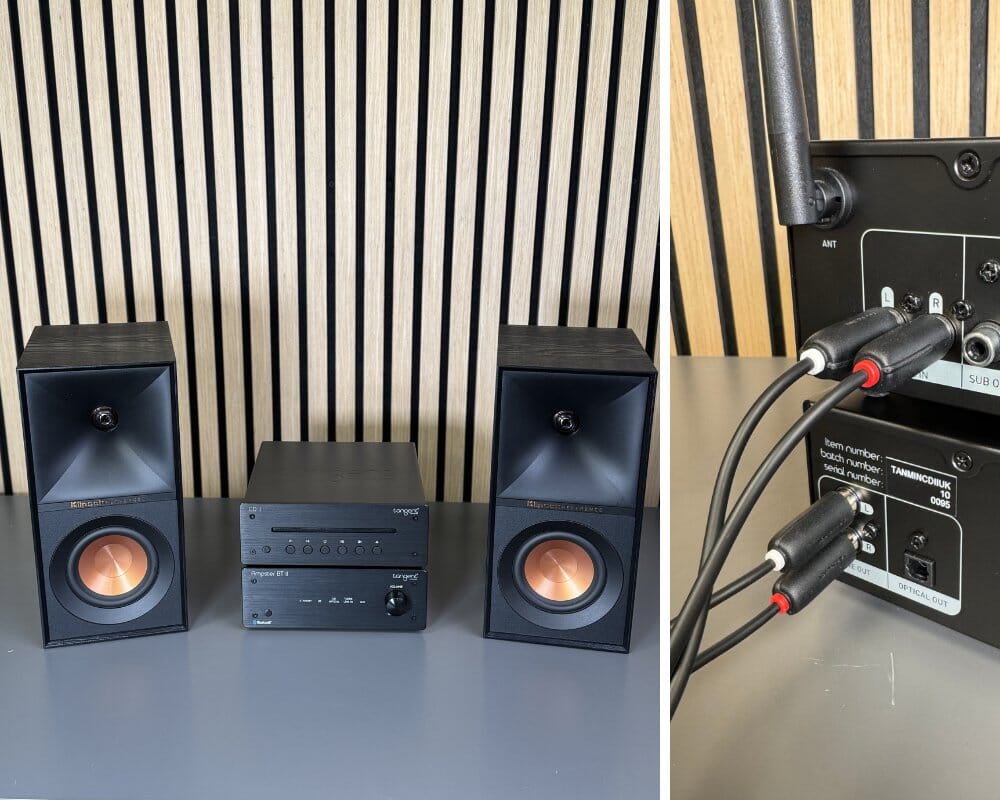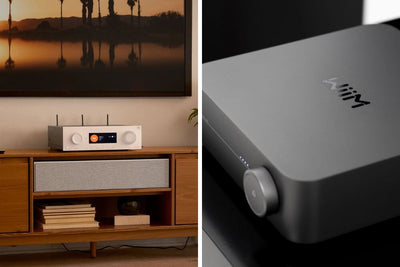CD players are still a fantastic way to enjoy high-quality audio, especially if you already have a collection of CDs.
If you’ve recently bought some active bookshelf speakers or an amplifier and want to connect a CD player to revive your collection then you’ll be pleased to know that the process is straightforward.
CD players typically have RCA or TOSLink digital audio connections, these are also commonly found on active bookshelf speakers and most amplifiers, so it’s usually pretty easy to connect the two together.
In most cases you’ll have more than one audio input so you can easily connect a CD Player, turntable & Wi-Fi streamer then simply switch between the inputs without having to unplug any cables.
Here's a step-by-step guide to help you set up a CD player with your audio system.
1. Connecting a CD Player to Active Speakers
Active speakers have a built-in amplifier, which means you don’t need a separate amplifier to power them. Connecting a CD player is quick and easy!

The most common CD players for adding onto active bookshelf speakers are the Tangent CD II and the Pro-Ject CD Box E. These are both high-spec, great value players that easily connect into the majority of our active speakers without taking up too much space.
Here’s how to connect your CD player directly to active speakers:
What You Need:
- A CD player with RCA or digital outputs.
- Active speakers with RCA, AUX or optical audio inputs.
- The appropriate cables (RCA, AUX, or optical).
How To Make The Connection Between CD Player & Active Speakers
Step 1: Check Your CD Player’s Outputs
Most CD players have RCA outputs (red and white), while some also have digital optical (TOSLINK) or coaxial outputs.

The connection on your CD player will determine which inputs your speakers will need in order to make the connection.
Step 2: Check Your Speakers Audio Inputs
Active speakers typically have RCA, AUX (3.5mm), optical, or coaxial inputs.
Make sure your speakers have a compatible input.

In most cases we’ll be using the red and white RCA audio inputs, but if your speakers and your CD player have an optical audio input then you can opt for this one instead for digital quality audio.
If your speakers only have a 3.5mm audio input then this isn’t a problem, you’ll just need to use an RCA to 3.5mm audio jack cable instead of an RCA to RCA.
Step 3: Make The Connection
Option 1: Using Analog RCA Audio Cables
Plug the red and white RCA cables from the CD player into the corresponding RCA inputs on your active speakers.

If your active speakers only have a 3.5mm AUX input, use an RCA to AUX adapter.
Option 2: Using Digital Optical Audio Cables
If your CD player has an optical (TOSLINK) output and your speakers have a matching input, use an optical or coaxial cable for better sound quality.

Step 4 Ready To Test
Power on both devices and select the correct input on your speakers.
Load up your favourite CD and press play.
If everything is connected properly then your speakers should spring to life.
2. Connecting a CD Player to an Amplifier (For Passive Speakers)
If you have passive speakers and an amplifier setup then you’ll be pleased to know that the process is pretty much the same as option 1 for active speakers.
Amplifiers usually have a lot more audio inputs than active speakers, you’ll probably find an input marked up as “CD” already. If not then look out for “AUX” or similar.

You have plenty of options for CD players, the two mentioned earlier are still a great option but you can also look at the Audiolab 6000CDT, Audiolab 7000CDT or the Arcam Radia CD5 players for something a bit more ‘high-end’.
Here’s how to connect a CD player to an amplifier:
What You Need:
- A CD player with RCA or optical audio outputs.
- An amplifier with compatible inputs.
- Passive speakers connected to the amplifier.
- The necessary cables (RCA or optical).
How To Make The Connection Between CD Player & Amplifiers
Step 1: Check Your CD Player Outputs & Amplifier Inputs
Most amplifiers have RCA inputs, and some have optical or coaxial inputs.
You need a matching pair in order to make the connection, so if your CD player has an RCA audio output then you’ll need an analog RCA or 3.5mm audio input on your amplifier.
Step 2: Make The Connection
Option 1: Using Analog RCA Audio Cables
Use RCA cables to connect the CD player’s RCA output to the amplifier’s RCA input.
Match the left (white) and right (red) channels correctly using an RCA cable.

Option 2: Using Digital Optical Audio Cables
If both your CD player and amplifier have optical (TOSLINK) or coaxial inputs, use an optical TOSLink cable.

Digital connections can provide better clarity and reduce interference.
Step 3: Turn Everything On and Adjust Settings
Power on your CD player, amplifier, and speakers.
Set the amplifier to the correct input source.
Adjust the volume and enjoy your CDs.
Final Thoughts
As you can see, adding a CD player to your active speakers or amplifier is a simple process.
For active speakers, RCA is often the most common method, while for amplifiers you’re more likely to have an optical audio input so digital connections are best.
If you’re looking for better sound quality, optical connections are the way to go.





